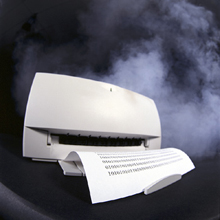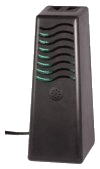Is Your Computer Printer Hazardous to Your Health?
by www.SixWise.com
Sitting next to a laser printer could be akin to having your desk next to a chain smoker, researchers from the Queensland University of Technology in Australia revealed in 2007.
|

Laser printers may emit ultra-fine particles that lodge deeply in your lungs, potentially leading to heart disease, cancer and respiratory illness.
|
Their groundbreaking study found 30 percent of the laser printers they tested released tiny particles of toner-like material into the air, in concentrations ranging from low to high. The particles were described as "causing lasting damage on the scale of inhaled cigarette smoke,” and breathing in these tiny particles has been linked to respiratory illness, heart disease, lung disease and cancer.
"Even very small concentrations can be related to health hazards," said author Lidia Morawska, director of the International Laboratory for Air Quality and Health at Queensland University of Technology in the San Francisco Chronicle. "Where the concentrations are significantly elevated means there is potentially a considerable hazard."
Alarmingly, the researchers found laser printers could increase particulate matter in the air by up to 400 percent.
The printers in the original study were manufactured by common names including Hewlett-Packard, Toshiba, Ricoh and Canon -- and all used toner instead of ink. What was mysterious about the study’s findings, however, was why certain printers emitted high levels of particles, while others were relatively low.
Now, a follow-up study by the same group of researchers may have discovered the reason for the discrepancy.
They tested two printers from the same manufacturer, one of which may emit 100,000 percent more particles into the air than the other. What they found was that a reaction between the air and organic compounds on the paper and from the toner was producing the toxic emissions -- and the temperature of various components within the printer was responsible for the increased levels.
The researchers concluded that printer companies should investigate the temperature issue in order to make their laser printers safer, but for now potentially dangerous versions still remain on the market.
What Can You do if You Work Near a Laser Printer?
Although Hewlett-Packard has dismissed the idea that printer emissions are a public health risk, you may still want to take some precautions.
Because of their small size, ultra-fine particles in the air are especially dangerous.
"Ultra-fine particles are of most concern because they can penetrate deep into the lungs where they can pose a significant health threat," Morawska told TheAge.com.
"These [printer] particles are tiny like cigarette smoke particles and, when deep inside the lung, they do the same amount of damage … The health effects from inhaling ultra-fine particles depend on particle composition, but the results can range from respiratory irritation to more severe illness such as cardiovascular problems or cancer,” she continued.
|
Purify Your Air, Fast, With PIONAIR
 With the PIONAIR Air Treatment System you can remove smoke, dust pet dander, mold, bacteria, pollen and more from your home and office air so you can breathe freely. With the PIONAIR Air Treatment System you can remove smoke, dust pet dander, mold, bacteria, pollen and more from your home and office air so you can breathe freely.
All PIONAIR Systems include a 30-Day Money-Back Guarantee!
And for a LIMITED TIME ONLY, Get $30 Off Each PIONAIR Air Treatment Unit, Plus FREE SHIPPING and a FREE MiniMate Refrigerator Unit!
|
Your risk of exposure, the researchers found, depends largely on the office building's ventilation system, which is why we highly recommend taking matters into your own hands and purifying your office air yourself.
The PIONAIR Smarte Pointe Air Treatment System, which Sixwise.com highly recommends, uses photocatalysis, which is designed to oxidize organic odors, germs, and fungi. The PIONAIR technology creates ultraviolet light rays, safe levels of ozone, and passive negative ions as part of your air treatment.
The SMART POINTE uses the same technology as the original PIONAIR system, with the added benefit of actively generated negative ions. These actively generated negative ions clear the air of particulate FASTER than the original PIONAIR system. Therefore, the PIONAIR SMART POINTE is effective against particulate such as pollen, dust, pet dander, and smoke, AS WELL AS mold, mildew, organic odors, and chemical vapors (such as formaldehyde).
The Pionair 350 Unit covers 150 to 350 sq. ft., and is perfect for a typical office. If you have a large office space, Pionair's 750 Unit covers 350 to 750 sq. ft., and if you work in a large, open environment, we recommend our largest Pionair, the 1500 Unit, which covers 750 to 1500 sq. ft.
Particularly if you work in a large space along with other workers, you may want to talk to your employer about getting one or more Pionair Units to clean the area’s air.
Keeping Your Office Air Pure is Essential to Good Health
Most Americans spend up to 90 percent of their time indoors and many spend most of their working hours in an office environment, according to the U.S. Environmental Protection Agency (EPA).
EPA studies show that indoor air can sometimes have higher levels of pollutants than outdoor air, and these indoor pollutants can increase your risk of illness.
“Several studies by EPA, states, and independent scientific panels have consistently ranked indoor air pollution as an important environmental health problem. While most buildings do not have severe indoor air quality problems, even well-run buildings can sometimes experience episodes of poor indoor air quality,” the EPA writes on their Web site.
Your office manager or employer should be proactively thinking about your office environment’s air quality.
|

If it’s not possible for you to purify your own workspace air (for instance if you work in an environment like the one in the photo), consider asking your employer to invest in The PIONAIR Smarte Pointe Air Treatment System for your entire office.
|
“Many common products used in offices, like solvents, adhesives, cleaners, and pesticides can give off pollutants and odors, as can office equipment such as copiers, printers, and fax machines,” writes the EPA. “If any of these items are used in the office environment, adequate and sometimes separate ventilation should be provided. If your organization engages in activities that may generate pollutants, such as photographic or printing processes, exhaust ventilation will be especially important.”
The EPA recommends that all office managers do the following to improve indoor office air:
-
Place office furniture and equipment with air circulation, temperature control, and pollutant removal functions of the heating, ventilating, and air conditioning (HVAC) system in mind.
Further, EVERYONE who works in an office environment can help improve air quality with these tips from the EPA:
Recommended Reading
Groundbreaking New Study Finds Household Cleaners & Air Fresheners Can Pose Serious Health Risks
The 17 Most Important Steps to Organize Your Office (Finally!)
Sources
Christopher Null: Yahoo Tech February 14, 2009
Ars Technica February 12, 2009
Theage.com July 31, 2007
EPA, Indoor Air Quality: An Office Building Occupant's Guide to Indoor Air Quality